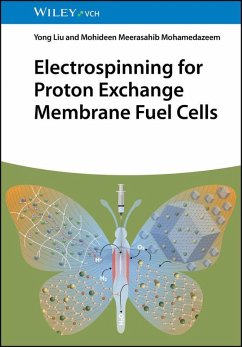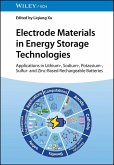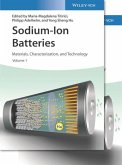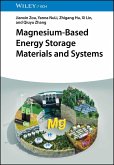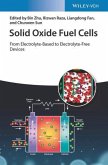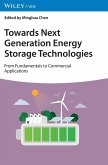- Gebundenes Buch
- Merkliste
- Auf die Merkliste
- Bewerten Bewerten
- Teilen
- Produkt teilen
- Produkterinnerung
- Produkterinnerung
Focuses on the design, characteristics, performance and development potential of key components of PEMFC through electrospinning technologies.
Andere Kunden interessierten sich auch für
![Electrode Materials in Energy Storage Technologies Electrode Materials in Energy Storage Technologies]() Electrode Materials in Energy Storage Technologies127,13 €
Electrode Materials in Energy Storage Technologies127,13 €![Sodium-Ion Batteries Sodium-Ion Batteries]() Sodium-Ion Batteries289,00 €
Sodium-Ion Batteries289,00 €![Magnesium-Based Energy Storage Materials and Systems Magnesium-Based Energy Storage Materials and Systems]() Jianxin ZouMagnesium-Based Energy Storage Materials and Systems90,99 €
Jianxin ZouMagnesium-Based Energy Storage Materials and Systems90,99 €![Solid Oxide Fuel Cells Solid Oxide Fuel Cells]() Solid Oxide Fuel Cells126,99 €
Solid Oxide Fuel Cells126,99 €![Towards Next Generation Energy Storage Technologies Towards Next Generation Energy Storage Technologies]() Towards Next Generation Energy Storage Technologies111,99 €
Towards Next Generation Energy Storage Technologies111,99 €![Rechargeable Ion Batteries Rechargeable Ion Batteries]() Rechargeable Ion Batteries155,00 €
Rechargeable Ion Batteries155,00 €![Electrochemical Energy Storage Devices Electrochemical Energy Storage Devices]() Electrochemical Energy Storage Devices104,99 €
Electrochemical Energy Storage Devices104,99 €-
-
-
Focuses on the design, characteristics, performance and development potential of key components of PEMFC through electrospinning technologies.
Produktdetails
- Produktdetails
- Verlag: Wiley-VCH
- Artikelnr. des Verlages: 1135462 000
- 1. Auflage
- Seitenzahl: 272
- Erscheinungstermin: 22. Oktober 2025
- Englisch
- Abmessung: 246mm x 172mm x 18mm
- Gewicht: 666g
- ISBN-13: 9783527354627
- ISBN-10: 352735462X
- Artikelnr.: 74140207
- Herstellerkennzeichnung
- Wiley-VCH GmbH
- Boschstraße 12
- 69469 Weinheim
- wiley-vch@kolibri360.de
- Verlag: Wiley-VCH
- Artikelnr. des Verlages: 1135462 000
- 1. Auflage
- Seitenzahl: 272
- Erscheinungstermin: 22. Oktober 2025
- Englisch
- Abmessung: 246mm x 172mm x 18mm
- Gewicht: 666g
- ISBN-13: 9783527354627
- ISBN-10: 352735462X
- Artikelnr.: 74140207
- Herstellerkennzeichnung
- Wiley-VCH GmbH
- Boschstraße 12
- 69469 Weinheim
- wiley-vch@kolibri360.de
Yong Liu is a professor at the College of Materials Science and Engineering, Beijing University of Chemical Technology, China. His research focuses on the preparation and application of polymer and nanocomposite materials. Dr. Mohideen Meerasahib Mohamedazeem is a Materials Science expert with a deep focus on sustainable energy solutions. He received an International Scientist funding award from the Beijing Natural Science Foundation, where he will lead a project from 2024 to 2026.
Chapter 1 Introduction to Proton Exchange Membrane Fuel Cells
1.1.Overview of Proton Exchange Membrane Fuel Cells technology
1.2 Key Components of Proton Exchange Membrane Fuel Cell
Chapter 2 Classification of Catalyst For Proton Exchange Membrane Fuel Cell
2.1. State-of-the-Art of Electrocatalysts
2.2. Fabrication of Catalyst Layers (CL) in Proton Exchange Membrane Fuel Cell
2.3. Conclusion
Chapter 3 Electrospun Catalyst Layer For Proton Exchange Membrane Fuel Cell
3.1 Introduction
3.2 Materials Preparation
3.3 Preparation and Electrochemical Characterization
3.4 Results and Discussion
3.5. Conclusion
Chapter 4 Analysis of Nanofiber Catalyst Layers Performance under Various Temperature and Humidity Conditions
4.1 Introduction
4.2. Materials Preparation
4.3. Result and Discussion
4.4 Conclusion
Chapter 5 The Role and Performance of Gas Diffusion Layers in Proton Exchange Membrane Fuel Cell
5.1. Introduction
5.2. Research on Gas Diffusion Layer and Water/Gas Transport Mechanisms
5.3 Conclusion
Chapter 6 Preparation of Gradient Gas Diffusion Layer Process and Their Performance in Fuel Cell
6.1 Introduction
6.2 Materials Preparation
6.3 Results and Discussion
6.4 Conclusion
Chapter 7 Impact of Optimizing the Thickness Direction of Gradient Gas Diffusion Layer on Water-Gas Management Capability of the Fuel Cell
7.1 Introduction
7.2 Materials Preparation
7.3 Results and Discussion
7.4 Conclusion
Chapter 8 Study on the Effect of Gradient Hydrophobic Treatment of Gas Diffusion Layer on Water Management Performance in Fuel Cells
8.1 Introduction
8.2 Materials Preparation
8.3 Results and Discussion
8.4 Comparison of Membrane Electrodes
8.5 Conclusion
Chapter 9 Fundamentals of Proton Exchange Membranes
9.1 Introduction
9.2 Conclusion
Chapter 10 Design of proton exchange membrane
10.1. Introduction
10.2. Design of Molecular Structure
10.3. Physical and Chemical Cross-Linking Modification
10.4. Enhancing Stability and Performance through Chemical Cross-Linking
10.5 Modulating the Structure of Ordered Microporous Materials
10.6 Construction of Novel Proton Transport Channels
10.7 Conclusion
Chapter 11 Highly Sulfonated Poly(Ether Ether ketone) Nanofibers Constructed Plasmonic Transport Channels
11.1 Introduction
11.2 Materials Preparation
11.3 Results and Discussion
11.4 Conclusion
Chapter 12 Poly(dopamine)-modified Eclogite Nanotube/Sulfonated Poly(Ether Ether Ketone) Cross-Linked Composite Membrane
12.1 Introduction
12.3 Results and Discussion
12.4 Conclusion
Chapter 13 Construction of Ordered Proton Transport Channels with Phosphotungstic Acid Modified Magnetic Nanoparticles
13.1 Introduction
13.2 Materials Preparation
13.3 Result and discussion
13.4 Conclusion
Chapter 14 Chemical Covalent Bonding of Silicotungstic Acid Proton Exchange Membrane
14.1 Introduction
14.2 Materials Preparation
14.3 Results and Discussion
14.4 Conclusion
1.1.Overview of Proton Exchange Membrane Fuel Cells technology
1.2 Key Components of Proton Exchange Membrane Fuel Cell
Chapter 2 Classification of Catalyst For Proton Exchange Membrane Fuel Cell
2.1. State-of-the-Art of Electrocatalysts
2.2. Fabrication of Catalyst Layers (CL) in Proton Exchange Membrane Fuel Cell
2.3. Conclusion
Chapter 3 Electrospun Catalyst Layer For Proton Exchange Membrane Fuel Cell
3.1 Introduction
3.2 Materials Preparation
3.3 Preparation and Electrochemical Characterization
3.4 Results and Discussion
3.5. Conclusion
Chapter 4 Analysis of Nanofiber Catalyst Layers Performance under Various Temperature and Humidity Conditions
4.1 Introduction
4.2. Materials Preparation
4.3. Result and Discussion
4.4 Conclusion
Chapter 5 The Role and Performance of Gas Diffusion Layers in Proton Exchange Membrane Fuel Cell
5.1. Introduction
5.2. Research on Gas Diffusion Layer and Water/Gas Transport Mechanisms
5.3 Conclusion
Chapter 6 Preparation of Gradient Gas Diffusion Layer Process and Their Performance in Fuel Cell
6.1 Introduction
6.2 Materials Preparation
6.3 Results and Discussion
6.4 Conclusion
Chapter 7 Impact of Optimizing the Thickness Direction of Gradient Gas Diffusion Layer on Water-Gas Management Capability of the Fuel Cell
7.1 Introduction
7.2 Materials Preparation
7.3 Results and Discussion
7.4 Conclusion
Chapter 8 Study on the Effect of Gradient Hydrophobic Treatment of Gas Diffusion Layer on Water Management Performance in Fuel Cells
8.1 Introduction
8.2 Materials Preparation
8.3 Results and Discussion
8.4 Comparison of Membrane Electrodes
8.5 Conclusion
Chapter 9 Fundamentals of Proton Exchange Membranes
9.1 Introduction
9.2 Conclusion
Chapter 10 Design of proton exchange membrane
10.1. Introduction
10.2. Design of Molecular Structure
10.3. Physical and Chemical Cross-Linking Modification
10.4. Enhancing Stability and Performance through Chemical Cross-Linking
10.5 Modulating the Structure of Ordered Microporous Materials
10.6 Construction of Novel Proton Transport Channels
10.7 Conclusion
Chapter 11 Highly Sulfonated Poly(Ether Ether ketone) Nanofibers Constructed Plasmonic Transport Channels
11.1 Introduction
11.2 Materials Preparation
11.3 Results and Discussion
11.4 Conclusion
Chapter 12 Poly(dopamine)-modified Eclogite Nanotube/Sulfonated Poly(Ether Ether Ketone) Cross-Linked Composite Membrane
12.1 Introduction
12.3 Results and Discussion
12.4 Conclusion
Chapter 13 Construction of Ordered Proton Transport Channels with Phosphotungstic Acid Modified Magnetic Nanoparticles
13.1 Introduction
13.2 Materials Preparation
13.3 Result and discussion
13.4 Conclusion
Chapter 14 Chemical Covalent Bonding of Silicotungstic Acid Proton Exchange Membrane
14.1 Introduction
14.2 Materials Preparation
14.3 Results and Discussion
14.4 Conclusion
Chapter 1 Introduction to Proton Exchange Membrane Fuel Cells
1.1.Overview of Proton Exchange Membrane Fuel Cells technology
1.2 Key Components of Proton Exchange Membrane Fuel Cell
Chapter 2 Classification of Catalyst For Proton Exchange Membrane Fuel Cell
2.1. State-of-the-Art of Electrocatalysts
2.2. Fabrication of Catalyst Layers (CL) in Proton Exchange Membrane Fuel Cell
2.3. Conclusion
Chapter 3 Electrospun Catalyst Layer For Proton Exchange Membrane Fuel Cell
3.1 Introduction
3.2 Materials Preparation
3.3 Preparation and Electrochemical Characterization
3.4 Results and Discussion
3.5. Conclusion
Chapter 4 Analysis of Nanofiber Catalyst Layers Performance under Various Temperature and Humidity Conditions
4.1 Introduction
4.2. Materials Preparation
4.3. Result and Discussion
4.4 Conclusion
Chapter 5 The Role and Performance of Gas Diffusion Layers in Proton Exchange Membrane Fuel Cell
5.1. Introduction
5.2. Research on Gas Diffusion Layer and Water/Gas Transport Mechanisms
5.3 Conclusion
Chapter 6 Preparation of Gradient Gas Diffusion Layer Process and Their Performance in Fuel Cell
6.1 Introduction
6.2 Materials Preparation
6.3 Results and Discussion
6.4 Conclusion
Chapter 7 Impact of Optimizing the Thickness Direction of Gradient Gas Diffusion Layer on Water-Gas Management Capability of the Fuel Cell
7.1 Introduction
7.2 Materials Preparation
7.3 Results and Discussion
7.4 Conclusion
Chapter 8 Study on the Effect of Gradient Hydrophobic Treatment of Gas Diffusion Layer on Water Management Performance in Fuel Cells
8.1 Introduction
8.2 Materials Preparation
8.3 Results and Discussion
8.4 Comparison of Membrane Electrodes
8.5 Conclusion
Chapter 9 Fundamentals of Proton Exchange Membranes
9.1 Introduction
9.2 Conclusion
Chapter 10 Design of proton exchange membrane
10.1. Introduction
10.2. Design of Molecular Structure
10.3. Physical and Chemical Cross-Linking Modification
10.4. Enhancing Stability and Performance through Chemical Cross-Linking
10.5 Modulating the Structure of Ordered Microporous Materials
10.6 Construction of Novel Proton Transport Channels
10.7 Conclusion
Chapter 11 Highly Sulfonated Poly(Ether Ether ketone) Nanofibers Constructed Plasmonic Transport Channels
11.1 Introduction
11.2 Materials Preparation
11.3 Results and Discussion
11.4 Conclusion
Chapter 12 Poly(dopamine)-modified Eclogite Nanotube/Sulfonated Poly(Ether Ether Ketone) Cross-Linked Composite Membrane
12.1 Introduction
12.3 Results and Discussion
12.4 Conclusion
Chapter 13 Construction of Ordered Proton Transport Channels with Phosphotungstic Acid Modified Magnetic Nanoparticles
13.1 Introduction
13.2 Materials Preparation
13.3 Result and discussion
13.4 Conclusion
Chapter 14 Chemical Covalent Bonding of Silicotungstic Acid Proton Exchange Membrane
14.1 Introduction
14.2 Materials Preparation
14.3 Results and Discussion
14.4 Conclusion
1.1.Overview of Proton Exchange Membrane Fuel Cells technology
1.2 Key Components of Proton Exchange Membrane Fuel Cell
Chapter 2 Classification of Catalyst For Proton Exchange Membrane Fuel Cell
2.1. State-of-the-Art of Electrocatalysts
2.2. Fabrication of Catalyst Layers (CL) in Proton Exchange Membrane Fuel Cell
2.3. Conclusion
Chapter 3 Electrospun Catalyst Layer For Proton Exchange Membrane Fuel Cell
3.1 Introduction
3.2 Materials Preparation
3.3 Preparation and Electrochemical Characterization
3.4 Results and Discussion
3.5. Conclusion
Chapter 4 Analysis of Nanofiber Catalyst Layers Performance under Various Temperature and Humidity Conditions
4.1 Introduction
4.2. Materials Preparation
4.3. Result and Discussion
4.4 Conclusion
Chapter 5 The Role and Performance of Gas Diffusion Layers in Proton Exchange Membrane Fuel Cell
5.1. Introduction
5.2. Research on Gas Diffusion Layer and Water/Gas Transport Mechanisms
5.3 Conclusion
Chapter 6 Preparation of Gradient Gas Diffusion Layer Process and Their Performance in Fuel Cell
6.1 Introduction
6.2 Materials Preparation
6.3 Results and Discussion
6.4 Conclusion
Chapter 7 Impact of Optimizing the Thickness Direction of Gradient Gas Diffusion Layer on Water-Gas Management Capability of the Fuel Cell
7.1 Introduction
7.2 Materials Preparation
7.3 Results and Discussion
7.4 Conclusion
Chapter 8 Study on the Effect of Gradient Hydrophobic Treatment of Gas Diffusion Layer on Water Management Performance in Fuel Cells
8.1 Introduction
8.2 Materials Preparation
8.3 Results and Discussion
8.4 Comparison of Membrane Electrodes
8.5 Conclusion
Chapter 9 Fundamentals of Proton Exchange Membranes
9.1 Introduction
9.2 Conclusion
Chapter 10 Design of proton exchange membrane
10.1. Introduction
10.2. Design of Molecular Structure
10.3. Physical and Chemical Cross-Linking Modification
10.4. Enhancing Stability and Performance through Chemical Cross-Linking
10.5 Modulating the Structure of Ordered Microporous Materials
10.6 Construction of Novel Proton Transport Channels
10.7 Conclusion
Chapter 11 Highly Sulfonated Poly(Ether Ether ketone) Nanofibers Constructed Plasmonic Transport Channels
11.1 Introduction
11.2 Materials Preparation
11.3 Results and Discussion
11.4 Conclusion
Chapter 12 Poly(dopamine)-modified Eclogite Nanotube/Sulfonated Poly(Ether Ether Ketone) Cross-Linked Composite Membrane
12.1 Introduction
12.3 Results and Discussion
12.4 Conclusion
Chapter 13 Construction of Ordered Proton Transport Channels with Phosphotungstic Acid Modified Magnetic Nanoparticles
13.1 Introduction
13.2 Materials Preparation
13.3 Result and discussion
13.4 Conclusion
Chapter 14 Chemical Covalent Bonding of Silicotungstic Acid Proton Exchange Membrane
14.1 Introduction
14.2 Materials Preparation
14.3 Results and Discussion
14.4 Conclusion

